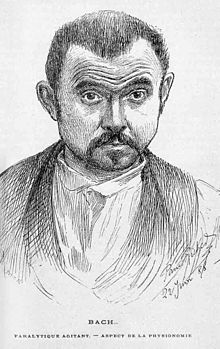Mask face
As a mask face (engl. Mask face, mask-like face ) is referred to in the medical a solidified, mask-like face without any visible expression . This form of hypomimia is particularly characteristic of Parkinson's disease , often coupled with an open mouth and a rare blinking of the eye. With increased sebum production, there is also a shiny "ointment face". Hypomimia occurs in scleroderma due to the hardening of the skin, but also occurs in other neurological diseases that involve the cranial nerves . In newborn is a congenital myopathy or one -Willi syndrome Prader thinking. In the rare congenital disease of the Nablus mask-like facial syndrome , the mask face is the main symptom. Hypomimia is an undesirable side effect after the administration of a neuroleptic ( Parkinsonoid ). Hypomimia can occur as part of botulinum toxin (botox) therapy .
Individual evidence
- ↑ Bastian Schmidt: Die facetten des Parkinson (2nd edition): The Parkinson's disease in clinical, historical and sociocultural consideration . epubli, March 25, 2014, ISBN 978-3-8442-9017-2 , p. 61.
- ^ Pschyrembel Online. Retrieved June 4, 2019 .
- ^ Christian Bischoff, Wilhelm Johannes Schulte-Mattler, Bastian Conrad: The EMG book: EMG and peripheral neurology in questions and answers . Georg Thieme Verlag, 2005, ISBN 978-3-13-110342-0 , p. 307.
- ^ Nablus mask-like facial syndrome. In: Orphanet (Rare Disease Database).
- ↑ Reiner Thümler: Parkinson's disease: A guide for those affected and therapists . Springer-Verlag, March 7, 2013, ISBN 978-3-642-58548-7 , p. 126.
